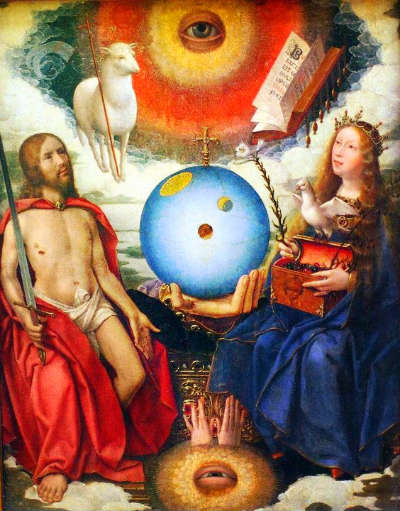Search:: Artists Alphabetically Artists by Country Artists by Century Artists by Movement
Jan
Provost
1365-1415
French Early Netherlandish Northen Renaissance Painter

Allegory of Christianity c.1515 by Jan Provoost
Jan Provost was a prolific artist working primarily in Antwerp. His paintings were acclaimed for their exceptional beauty and sensitivity. Author Carleton Noyes explains "This effluence of the soul within is the essential man; people call it the "expression." As with human life, so with the many aspects of nature. External traits are merged in the spiritual meaning. The material forms have the power of affecting the spirit thus or so; and in man's reaction on his universe they come to take on a symbolic emotional significance. Each manifestation of nature arouses in the artist, more or less consciously on his part, some feeling toward it: he cares, then, to represent these external material forms, whether a flower, a landscape, a human face, only because there is in them something in which he delights; he fashions the work of art in praise of the thing he loves. To the clever technician who imitatively paints the flower as he knows it to be."
Diffrences Between Northern Renaissance and Italian Renaissance Art
Many of the early paintings of the Northern Renaissance perished through time and the fierceness with which the Iconoclastic battles were waged. The Northern Renaissance was different from the Italian Renaissance in many ways. Painters of the North focused upon secular society rather than the Church and overblown religious themes. Northern Renaissance painters emphasis the daily life of the merchant and peasant class. They also put a greater emphasis on spirituality, piousness and living a simple life. Artists such as Dieric Bouts and Peter Brugal the Elder painted inspirational biblical scenes, the merchant class at work, idyllic scenes of peasants working at everyday tasks, playing games and feasting. Northern Renaissance painters seemed more in touch with the people. According to art historian John C. Van Dyke "As a whole their subjects were single figures or small groups in interiors, quiet scenes, family conferences, smokers, card-players, drinkers, landscapes, still-life, architectural pieces. ."The Italian Renaissance, on the other hand, focused more on the aristocracy and the theocracy. Painters highlighted the individual and glorified worldly pleasures, Paintings were sumptuous, elaborate, expressive, and exhalted wealthy and powerful people. Author Clive Bell observed "But whatever the Italian painters of the Renaissance had to say they said in the grand manner. Remember, we are not Dutchmen. Therefore let all your figures suggest the appropriate emotion by means of the appropriate gesture—the gesture consecrated by the great tradition. Straining limbs, looks of love, hate, envy, fear and horror, up-turned or downcast eyes, hands outstretched or clasped in despair."
The Italian Renaissance painters focused heavily on religion, Roman Catholicism. Popes and church hierarchy were wealthy, powerful rulers. Like kings they were depicted in elaborate settings swaddled in furs and silks.
Important Words, People, Phrases, Characteristics related to the Northern Renaissance Art Movement - allegorical painting, rebirth, invention of oil painting, Hieronymus Bosch, Limbourg Brothers, Desiderius Erasmus, Robert Campin, Jan Van Eyck, Jean Fouquet, Albrecht Dürer, Johannes Gutenberg, Johann Reuchlin, Martin Luther, rise of the merchant class, world landscape, Low Countries, Protestant Reformation, Calvinisim, glazing, impasto, scriptorium, illuminator, invention of the printing press, woodcuts, engravings, Antwerp School, Guild of Saint Luke, commerce, Flemish School, Northern Europe, Flanders, Bruges, renewed interest in classical learning, mythological scenes, genre painting, landscapes, portraits, moralizing overtones, human vices, lust, paradise, spirituality, piousness, living a simple life, reform, Human Reasoning, tradesmen at work, idyllic scenes of peasants, playing games, feasting, linear perspective, \Heliocentric Theory, humour, satire, spiritually significant, illuminated manuscript, idealized biblical themes, scriptorium, emotion, illuminator, iconoclast, Age of Discovery, Virgin and Child, axonometric drawing, curiosity about the natural world, realistic use of colours and light, Old Testament stories, Gospel parables, The Blackdeath, Christian symbolism
Require more facts and information about Jan Provost and Art history? Dig around every nook and cranny of the known universe for information this subject. Search Here
☼☼☼☼☼
© HistoryofPainters.com If you like this page and wish to share it, you are welcome to link to it, with our thanks. updated 3/7/2017